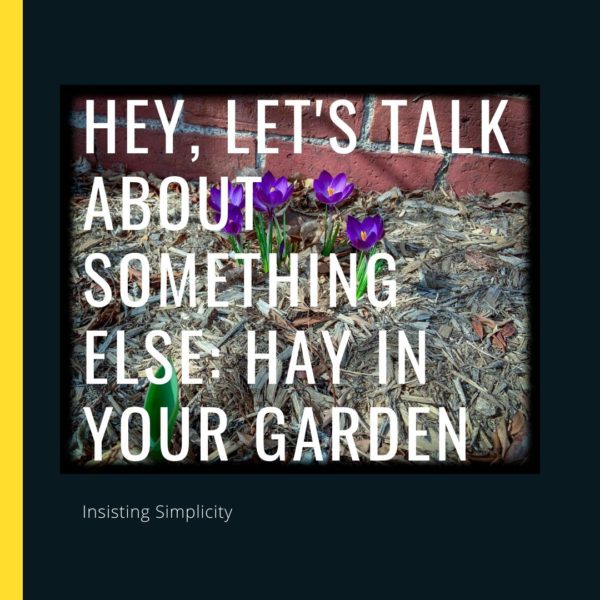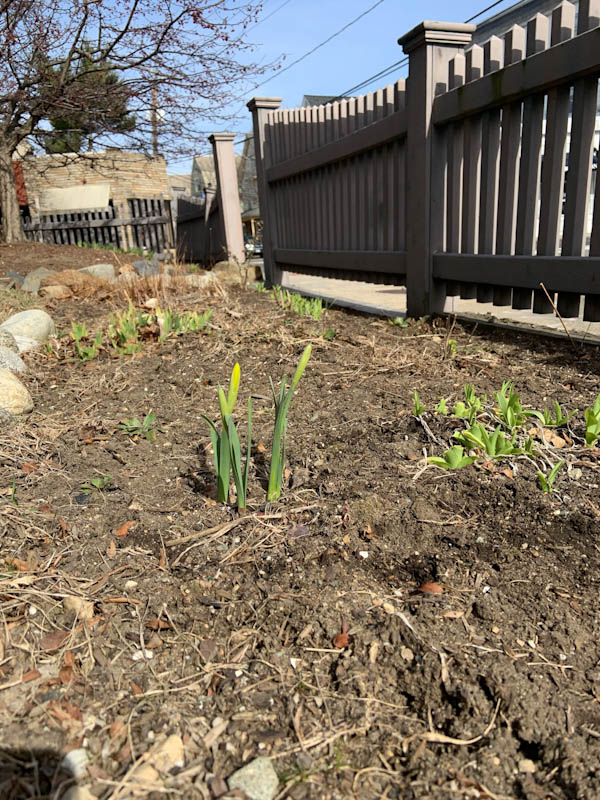Mulch on your mind? Probably not. As I write, the country, the world, is… tense, let’s put it. I mean not to make light of the situation, nor downplay its gravity. These are truly unprecedented times. Instead, I’d like to offer a simple distraction, a reprieve from whatever genuinely alarming thing is in front of you right now. The garden and the act of gardening, for many, is therapeutic. I’ve found myself out there more recently. Albeit a bit early maybe, considering it’s just now officially spring, but I’m out there. My natural, seasonal energy which grows as the temperature rises, suddenly kicked into overdrive by the nervous, excitable energy of the times. Gardens away! Which brings me back to hay. I want to incorporate permaculture/organic gardening-inspired techniques as we execute and hay, well… it sounds important. Please enjoy today’s post all about hay, featuring wisdom from some of those who came before us.

Hay, man! Is That Hay in Your Garden?
It may sound strange, but recently I’ve been thinking a lot about hay. Yeah, that hay. Not an acronym or a new tech or app… just… hay.
Now, before you conclude that I’ve come off my rocker completely… not sayin’ that I haven’t (weird eyebrow raise)… let me preface with this: much of the aforementioned pondering took place in our kitchen, whilst looking o’er our flower beds.
And, until very recently, upon looking out on said beds, an exposed, desiccated soil met my eyes.
Influenced by permaculturists, naturalists and organic farmers, soil-related thoughts swirled through my head. Meanwhile, poor soil wellness lay before me.
“This soil impoverishment is a travesty! It must be rectified!” As I seethed, the thought flashed in my brain:
“Hay, man!”
The Ruth Stout No-Work Garden Book Approach to Hay in the Garden
Permaculture is experiential. Nature reveals itself to the observant. Lessons are learned… mostly through failure… to be employed and adapted for future ventures. Ruth understood this. I imagine she was a pretty interesting character. Her feisty, confident, no-nonsense voice resonates with this reader, as she recounts a “… story of the things I have learned, and ‘unlearned'” in her book The Ruth Stout No-Work Garden Book: Secrets of the Famous Year-Round Mulch Method.
Over time, Ruth developed her own system. She experimented, she listened to “experts,” and then stopped listening. Eventually, a signature style emerged, defined by hay and “no-work.” She explains her process:
With the Stout system, spading, plowing and cultivating are all unnecessary, and do more harm than good. If a heavy hay cover is laid on even the toughest sod in the summer, plantings can be made through it the following spring. No other preparation of the soil is required.
Traditional monoculture cultivation techniques deplete the soil with each successive year. Ruth’s hay spreading practice, not only delivered more robust yields, but also acted as a natural fertilizer. Her system was additive to biodiversity and soil wellness, making additional measures to “fix” the land unnecessary.
If you use hay mulch continuously for a number of years, you can practically forget all about acid or alkaline soil problems — along with dusting and spraying and the use of chemical fertilizers and ‘soil conditioners.’ I grow everything from beets to blueberries under the Stout System, and pay no attention to acidity or alkalinity any more. My experience has been that ample organic matter acts as an effective buffer and helps neutralize extremes of pH in any soil.
Clever, yet humble, Ruth concedes there is no silver bullet and other organic material may be adequate. She emphasizes here preference for hay, but what if you used something else? And how does this practice look over time?
My own preference is for the Ruth Stout system of permanent hay mulch. But I have done well with leaves and other materials. If you grown corn as I do in the same area each year, returning all husks and stalks to the soil, it will soon be hard to say just what your mulch consists of.
Ruth Stout’s No-Work Garden Book may be right up your alley if you’re looking for a fun read with some practical guidance. However, Ruth cautions the aspiring gardener to: “learn as you go. But don’t be too sure of what you’ve learned.” That sounds about right to me.
One Straw Revolution Approach to Hay in the Garden
Masanobu Fukuoka’s One Straw Revolution is a masterpiece, but you already knew that because I told you. His writing is simple and beautiful. As with Ruth, Fukuoka’s teachings are the product of decades of experimentation. He writes:
I ultimately reached the conclusion that there was no need to plow, no need to apply fertilizer, no need to make compost, no need to use insecticide. When you get right down to it, there are few agricultural practices that are really necessary. The reason that man’s improved techniques seem to be necessary is that the natural balance has been so badly upset beforehand that the land has become dependent on them.
And, like Ruth, Fukuoka came to appreciate the power of something as simple as straw:
Spreading straw might be considered rather unimportant, but it is fundamental to my method of growing rice and winter grain. It is connected with everything, with fertility, with germination, with weeds,
with keeping away sparrows, with water management. In actual practice and in theory, the use of straw in farming is a crucial issue. This is something that I cannot seem to get people to understand.
From the rice paddies of Japan to the rocky fields of Connecticut, both Fukuoka and Stout understood the additive benefit of straw and it’s impact on soil health over time. He explains:
Scattering straw maintains soil structure and enriches the earth so that prepared fertilizer becomes unnecessary. This, of course, is connected with non-cultivation. My fields may be the only ones in Japan which have not been plowed for over twenty years, and the quality of the soil improves with each season. I would estimate that the surface layer, rich in humus, has become enriched to a depth of more than four inches during these years. This is largely the result of returning to the soil everything grown in the field but the grain itself.
While Stout entertains with wit, Fukuoka subtly connects with the metaphysical. Are we even talking about gardening anymore??? I’ll let you be the judge.
Hey, How Can I Use Hay in My Garden?
So, now that we’re all jazzed about hay, shall I talk about some ways to incorporate these ideas into our gardening this spring? What do you say? I just may.
Hey!
I see what you’re doing…
OK, just checking you’re still with me.

We need to begin by traveling back in time to last fall when we “winterized” our small raised bed. Did we use hay? Not exactly… I took a combination of compost, fine yard trimmings and leaves to build up a compostable, protective winter layer.
Like Ruth, I’m not letting the gardening police dictate here, I just threw together what was available. I made my own hay/mulch/whatever and laid ‘er down.
Fast forward to the present and we’re looking to rectify our flower bed situation.

Hay? I just may… No, OK.
Cedar mulch it is… but hey, can we somehow make it more nutrient-infused? make it better nourish the deficient soil underneath?
Yeah, I think we could do something here…
I’m not quite as far along as Stout and Fukuoka, but they had to start somewhere too, right? So, for now, my answer is to dump as much compost as possible underneath the cedar mulch. This represents somewhat of a balance between doing as much for the soil as possible, but also maintaining a somewhat “refined” aesthetic. As we experiment with raised beds and get deeper into growing our own plants, herbs and vegetables, I’ve got a feeling hay will become a more prominent feature of our gardens.
Conclusion
As the world continues to go haywire, I hope you’ve enjoyed these musings on a more palatable conversation topic. You may even modify your garden strategy. But hey, don’t let things around you get you down. Spring is here. The birds are returning and the crocuses are pushing their little bulbous heads through the ground to greet you a g’mornin’!
So long for now.

